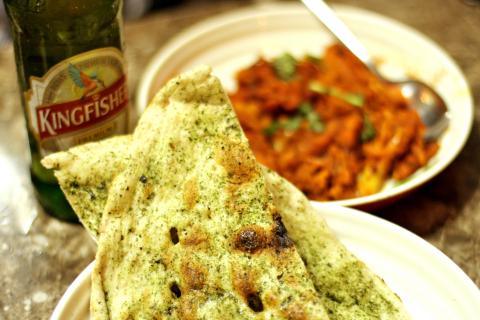Though it is located within sight of Taipei City Hall, Mayur Indian Kitchen is easy to miss because the small takeaway restaurant is tucked among a row of motorcycle repair shops and food stands behind the Keelung Road underpass. Mayur Indian Kitchen is just a kitchen counter with a few tables lined up on the sidewalk, but it offers a wide, constantly changing assortment of home-style Indian cooking. (A second location is located in New Taipei City’s St Ignatius Plaza (徐匯廣場) shopping mall).
Owner Mayur Srivastava worked as a hotel chef before opening Mayur Indian Kitchen six months ago. The eatery’s dishes are freshly prepared and feature whole spices instead of powdered versions. The restaurant specializes in north Indian cuisine, but also offers south Indian classics like dosa, or savory pancakes made from rice flour and lentils served with a variety of stuffings, and crispy samosas. The restaurant frequently changes its menus and offers specials depending on the season. For example, next week Mayur will began serving homemade yogurt, mango and lemon drinks for the warm weather.
“We keep changing our menu because we want to let people taste new things every time. There are so many dishes in India,” says Srivastava.

Photo: Catherine Shu, Taipei Times
The curries I ate at Mayur Indian Kitchen are mildly spicy, but can be made more piquant based on customer requests. The restaurant offers several jain, or vegetarian dishes, such as aloo gobhi (NT$110), which is made with sauteed potato, cauliflower, tomato and spices. I liked how the cauliflower was lightly cooked to retain some of its crunch. The tandoori chicken masala (NT$145) was also good, though most of the chicken was still on the bone and it became tiresome picking off the meat. My favorite dish of the night was the chana masala (NT$95), which paired very well with the butter naan (NT$55). Mayur Indian Kitchen’s freshly prepared version of the Indian flatbread is especially good: the edges are baked until crisp, while the middle is moist and chewy — just right for scooping up curry. The naan comes in 14 savory or sweet flavors. My companion and I also ordered the garlic version (NT$55), which was topped with a plentiful sprinkling of seaweed flakes. The flavor combination was fine but unexpected. We preferred how the plain butter naan tasted with our other dishes.
On a separate visit, I ordered a vegetarian lunch set with chickpea curry, which was made with a liberal helping of cumin. Even the simple cabbage salad included with the set was sprinkled with plenty of fennel seeds, which offered an interesting contrast to the tart vinegar dressing and was a cool palate cleanser after the rich curry and rice.
For dessert, Mayur Indian Kitchen offers both gulab jamun (deep-fried milk balls served in sugar syrup, NT$80) and gajar halwa (NT$95), which we ordered. The deliciously thick, sticky pudding-like dish is made with carrots and cashew nuts cooked in milk and made my sweet tooth very happy.

Photo: Catherine Shu, Taipei Times

Taiwan can often feel woefully behind on global trends, from fashion to food, and influences can sometimes feel like the last on the metaphorical bandwagon. In the West, suddenly every burger is being smashed and honey has become “hot” and we’re all drinking orange wine. But it took a good while for a smash burger in Taipei to come across my radar. For the uninitiated, a smash burger is, well, a normal burger patty but smashed flat. Originally, I didn’t understand. Surely the best part of a burger is the thick patty with all the juiciness of the beef, the

The ultimate goal of the Chinese Communist Party (CCP) is the total and overwhelming domination of everything within the sphere of what it considers China and deems as theirs. All decision-making by the CCP must be understood through that lens. Any decision made is to entrench — or ideally expand that power. They are fiercely hostile to anything that weakens or compromises their control of “China.” By design, they will stop at nothing to ensure that there is no distinction between the CCP and the Chinese nation, people, culture, civilization, religion, economy, property, military or government — they are all subsidiary

Nov.10 to Nov.16 As he moved a large stone that had fallen from a truck near his field, 65-year-old Lin Yuan (林淵) felt a sudden urge. He fetched his tools and began to carve. The recently retired farmer had been feeling restless after a lifetime of hard labor in Yuchi Township (魚池), Nantou County. His first piece, Stone Fairy Maiden (石仙姑), completed in 1977, was reportedly a representation of his late wife. This version of how Lin began his late-life art career is recorded in Nantou County historian Teng Hsiang-yang’s (鄧相揚) 2009 biography of him. His expressive work eventually caught the attention

This year’s Miss Universe in Thailand has been marred by ugly drama, with allegations of an insult to a beauty queen’s intellect, a walkout by pageant contestants and a tearful tantrum by the host. More than 120 women from across the world have gathered in Thailand, vying to be crowned Miss Universe in a contest considered one of the “big four” of global beauty pageants. But the runup has been dominated by the off-stage antics of the coiffed contestants and their Thai hosts, escalating into a feminist firestorm drawing the attention of Mexico’s president. On Tuesday, Mexican delegate Fatima Bosch staged a